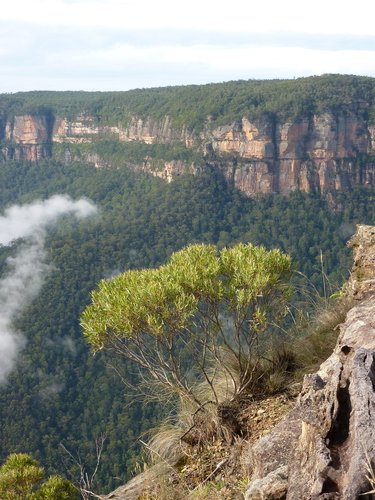Eucalyptus burgessiana - Faulconbridge Mallee Ash - Plant Profile
The Faulconbridge Mallee Ash, scientifically known as Eucalyptus burgessiana, is a small tree with a compact mallee habit. It typically reaches a height of up to 7 meters and spans a width of 3-5 meters. The plant is characterized by a lignotuber root system. Its flowers, appearing in white, cream, and yellow hues, bloom has been recorded in various months, including May, August, September, November, and December. Thriving in temperate climates, this species prefers full sun skeletal sand on sandstone soils with an Noteworthy for its frost tolerance and drought resistance, the Faulconbridge Mallee Ash is well-suited for garden styles inspired by Australian native or Mediterranean landscapes.
Eucalyptus cunninghamii - Cliff Mallee Ash - Plant Profile
Eucalyptus cunninghamii, commonly referred to as Cliff Mallee-ash, is a shrub to small tree Ranging from 0.5 to 2 meters in height and 1 to 4 meters in width, this species features densely held foliage atop numerous stems and roots characterized by a lignotuber. Its delicate white and green-white flowers grace the plant in recorded intervals during April, September, and December. Thriving in the natural habitat of Blue Mountains' Mallee Heath, steep slopes, and cliff edges, this resilient species is naturally restricted to cool-temperate climates on the upper Blue Mountains. It flourishes full sun and tolerates light shade, and enjoys eroded skeletal sandy soil on sandstone. Notably frost-hardy and drought tolerant.
Eucalyptus stricta - Blue Mountains Mallee Ash - Plant Profile
Eucalyptus Stricta, commonly known as the Blue Mountains Mallee Ash, is a small Mallee tree or mallee. This resilient plant, with a height ranging from 5 to 7 meters depending on the substrate, boasts a width of 3 to 5 meters. It forms roots system know as a lignotuber. The Blue Mountains Mallee Ash exhibits elegant small flowers on previous seasons growth in hues of white to cream. Thriving in temperate to cool-temperate climate zones, this species is somewhat versatile in its light requirements, flourishing in full sun and tolerating light shade. It proves to be hardy thriving in sandy, poor soils, with a preference for acidic to neutral pH levels. Notably frost-hardy, this plant showcases its hardiness in our tough australian climate.
Houseplant Spa Day: An Annual Deep Soak Guide for the Best Indoor Plants
Our houseplant spa day takes place over one day— one very busy day. Once the weather has warmed up enough and our houseplants are starting to wake up after their winter dormancy, We set aside a full day to give our plants a real treat! We pamper and preen them to get them ready for the growing season ahead.
El Niño Alert: Gardening Strategies for Changing Climates in Australia
Our gardens and many of our plants are in for a rude awakening! El Niño is back and the abundance of water is fast diminishing. This article will look in-depth at the signs you need to be looking out for and how to build resilience in your garden once again.
Ultimate Guide to Selecting the Right Live Potted Christmas Tree
A beautiful reason to keep a live tree is that it will grow with your family throughout the years. It’s magical to look back and see photos of your tree with your family and know it’s the same majestic tree year on year sharing in the holiday spirit, it brings a sence of joy knowing our tree has been apart of years worth of fond memories.
How to: Caring for Live Potted Christmas Trees
Your tree needs a full sun position with even light. Full sun means a position that gets a minimum of 6 hours of direct sun light each day, the more the merrier. Even light refers to the plant being able to get the light from all aspects.
A Veggie Wet Start to Summer - The Lodge Garden Update.
A veggie wet start to summer. This week week in our garden we are pulling the veggie patch to pieces and replanting after cabbage moth caterpillar plague.
Water Repelling Soil in the Home Gardens: Causes, Signs, and Solutions Revealed!
Australia has more than its fair share of water repelling soil Hydrophobic soil is particularly prevalent in sandy soils, cheap or old potting mix. Learn how to fix your soil!
Pining for Compost: Pine needles, Can I Compost them?
So, can you really compost pine needles? The answer is YES But wait there are some things you seriously need to know before you do.










